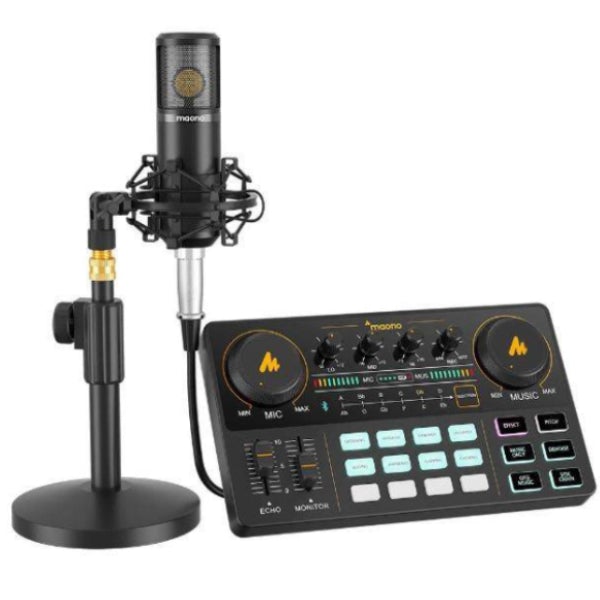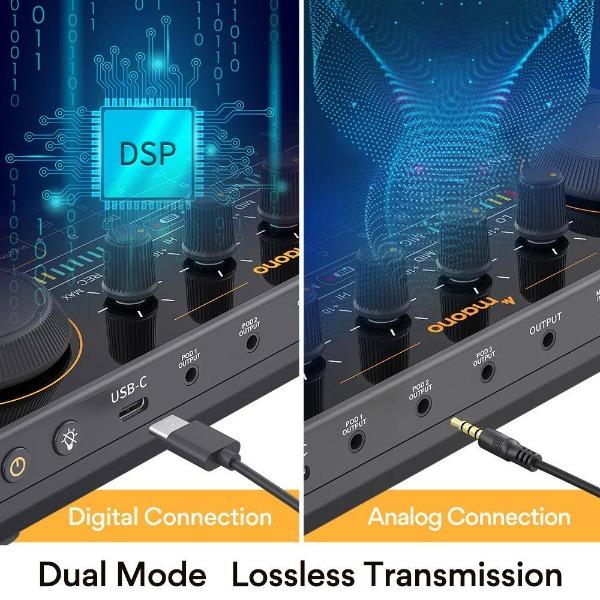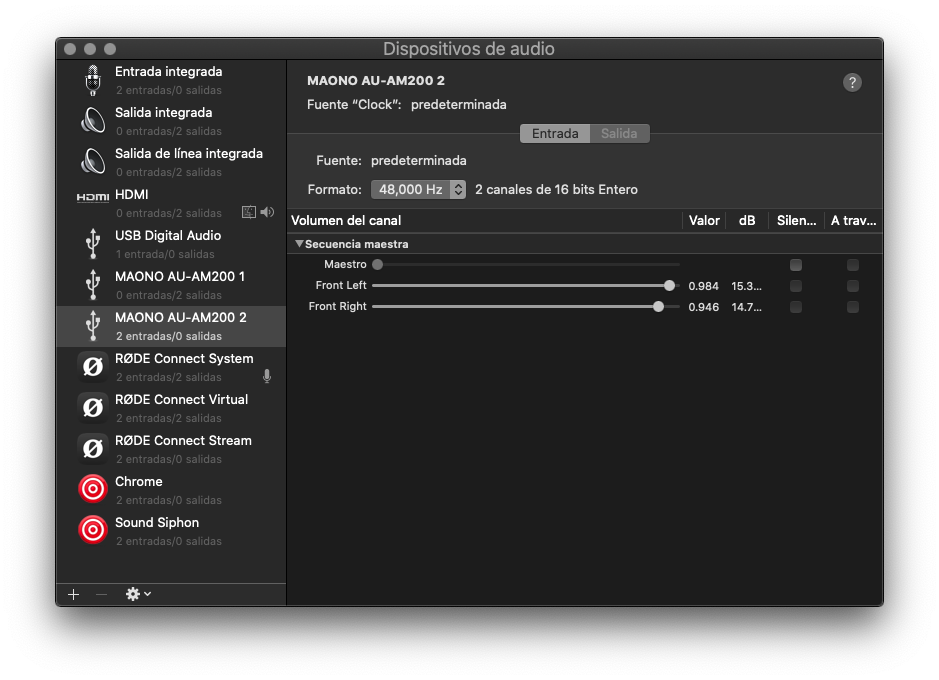
Here is my review on the MAONOCaster Lite AU-M200 interface/mixer Premium Bundle, which includes some very powerful 48 kHz digital processing/mixing, a condenser microphone, shockmount, windscreen and table stand. After the launch of the RØDECaster Pro in 2018, there has fortunately been a growing list of powerful audio devices from several manufacturers which combine and facilitate many audio functions for live or live-to-drive recording for audio-only or audio-with-video shows. Those functions often include audio mixing of multiple sources, playback of pre-recorded virtual carts (aka “soundpads”) and direct connections to smartphones or computers via Bluetooth, TRRS or USB with built-in mix-minus (although only partial mix-minus with the MAONOCaster Lite AU-M200). As I am about to describe in detail, the MAONOCaster Lite AU-M200 interface/mixer Premium Bundle represents the least expensive of all such devices currently on the market, including a proper 48 kHz digital output for recording or live broadcast/streaming. Although more limited than more costly devices from Maono itself and other manufacturers, the MAONOCaster Lite AU-M200 interface/mixer Premium Bundle indeed offers a great value for certain applications, as long as you understand and accept its limitations.
USB-C connection and usage

The MAONOCaster Lite’s USB-C connection is for both data and to charge the internal lithium battery, which is rated at eight hours of usage/autonomy. Charging takes about three hours.

The output of the USB-C indeed offers 48 khz/16-bit encoding (See screenshot above and 48kHzAlliance.com for more information.). That’s how I set it and made my test recording with Hindenburg Pro). However, the decoding is surprisingly limited to only 44.1 kHz/16-bit. See screenshot below.)
Of course, this will not affect the quality of the local microphone(s) when used for conferencing with the services below (or if recording/broadcasting/streaming via USB-C).
The USB-C connected to a computer can be used to record or for live broadcast/streaming. It can also be used for remote guests as long as the LOOP BACK is disabled in the MAONOCaster Lite. This is ideal if used with services including Cleanfeed, Google Meet, Riverside.fm, Zoom.us, etc. The best live audio quality of those is achieved from Cleanfeed, as I have covered in many other articles.)
In this case, you must record/broadcast/stream from one or more of the analog outputs. There will be more details ahead. If you are not conferencing, you should activate the LOOP BACK and then you can record/broadcast/stream via the USB-C.
Audio sources and destinations
As a mixer, the MAONOCaster Lite AU-M200 can receive audio from multiple sources, including:
- USB-C bidirectional port
- Bluetooth (for playback only, not for conferencing)
- Its internal virtual carts (aka “sound pads”, more details ahead)
- A MUSIC INPUT via TRS 3.5 mm (for playback only, not for conferencing)
- Three line-level outputs for recording or live broadcasting/streaming-only via TRRS 3.5 mm (i.e. telephone or tablet)
- A TRS 3.5 mm stereo headset
- Two (2) TRS 3.5 mm microphone inputs with bias voltage (“plugin power”, not phantom power)
Even with all of those sources are available, please note that the MAONOCaster Lite AU-M200 only has two potentiometer knobs for sources. One of the two potentiometer knobs is labeled MIC (for all of the connected microphones) and one labeled MUSIC (which can come from any of the mentioned sources). So if you are going to connect two (2) microphone sources, you will only have direct access to control the global gain of the pair of microphones. If you use two microphones and those two microphones do not have equal levels, see my solution for that ahead in this article.
Echo function
There are also sliders for the Echo effect feature and Monitor (for your headphones). Note that the Echo effect feature indeed is audible via the analog outputs. However, they don’t affect recordings made via the USB-C connection, although the other digital effects indeed are included via USB-C.
Equalizer knobs
There are equalizer knobs for the local microphone(s). I left them in flat in my test recordings.
Wide compatibility of computing platforms
The MAONOCaster Lite AU-M200 is officially compatible with Android, iOS, macOS and Windows.
Powerful DSP (digital signal processor)
I am amazed at all of the power included at the MAONOCaster Lite AU-M200’s price point. The terms written below in all uppercase match the corresponding button. I’ll explain what each one does in the case of the MAONOCaster Lite AU-M200 if not self-explanatory:
- DENOISE (This is a fixed setting which affects only the microphone inputs. It seems to be a fixed gate. I am not sure if it also includes any high pass filter, aka low cut filter or other type of intelligent noise reduction.)
- ELECTRON (Electronic music key changer with 12 notes)
- EFFECT (These are sequential vocal effects including original sound, pro, pop and yelling mode, which is called “M.C.” by the voice prompt.)
- LOOP BACK (This controls whether the background music or other sound from the computer connected via USB-C should be routed back to the computer or not. When deactivated, the MAONOCaster Lite can be used to have a perfect mix-minus sent to the computer, to send everything to the computer except the sounds that came from the computer. This is ideal if used with remote guests including Cleanfeed, Google Meet, Riverside.fm, Zoom.us, etc. The best live audio quality of those is achieved from Cleanfeed. In this case, you must record/broadcast/stream from one of the analog outputs.)
- MUSIC ONLY (Attempts to remove the vocal portion of commercial songs, for their use with karaoke when you can’t find the official karaoke version.)
- PITCH (exaggerated female, exaggerated male, baby, robot for the microphone inputs)
- REVERB (variable via slider for the microphone inputs, although affects the analog outputs only, not the USB-C output)
- SIDE CHAIN (In this case, it refers to ducking, so when the host speaks, it lowers the music accordingly.)
- Virtual carts (“soundpads”, see the dedicated section ahead for details)
Note that Pitch and Vocal effects cannot be combined. One or the other works at any moment. If you don’t want any of the four pitch options, you must activate vocal effects. If you don’t want pitch changes or vocal effects, set the vocal effect to Original. That is the way I did most of the test recordings, except when demonstrating the Pitch effects.
About the virtual carts (“soundpads”)
The MAONOCaster Lite AU-M200 includes twelve virtual carts (“soundpads”), although eight of them are permanently pre-assigned with the following sounds:
- Opening
- Applause
- Gunshot
- Laughter
- Booing
- Awkward
- Slapping
- Cheering
The remaining four buttons are user-assignable to other sounds you way want to load there. The way to get a sound onto one of the four user-assignable buttons is via recording them from a microphone or external audio source (not by importing a file).
Partial mix-minus
With many other of these new special audio devices I have tested to date, the mix-minus is complete (i.e. it works for many available remote audio sources), while as with the MAONOCaster Lite AU-M200 it is incomplete, since it works only with the USB-C source. To Maono’s credit, they don’t even advertise any mix-minus at all with the MAONOCaster Lite AU-M200, but indeed it has it, if activated and used specifically as explained ahead.
Mix-minus recap
For those unfamiliar with the concept of mix-minus, it has been both a technique and a feature which allows remote guests in a show to hear everything in a show’s mix except themselves (i.e. everything minus themselves) to avoid hearing an echo of their own voices due to the inevitable delay. Traditionally (with most consumer hardware audio mixers before 2018), mix-minus has been achieved with audio mixers which have one (or more) aux buses (auxiliary buses), since one is required for each simultaneous remote caller. Even though for some people, the concept of creating a mix-minus is simple and easy to achieve, for others it has been very difficult to achieve the traditional way. That’s why the manufacturers of these special devices have created what I call foolproof and bulletproof mix-minus. In some cases, the mix-minus is already active with all inputs made for remote guests. In other cases (especially with USB sources/destinations), it is optional in a menu.
When I say that with the MAONOCaster Lite AU-M200 it is incomplete, I mean the following that it only works with the USB-C port with the LOOP BACK button deactivated. This is ideal if used with remote guests including Cleanfeed, Google Meet, Riverside.fm, Zoom.us, etc. The best live audio quality of those is achieved from Cleanfeed, although Cleanfeed is audio-only. If you need both video and audio with a single source, consider Riverside.fm.)
In this case, you must record/broadcast/stream from one or more of the analog outputs, i.e. the smartphones shown above.
What comes included with the MAONOCaster Lite AU-M200 interface/mixer Premium Bundle
- MAONOCaster Lite AU-M200 interface/mixer
- Condenser microphone
- Table stand for condenser microphone
- Shockmount for condenser microphone
- Windscreen for condenser microphone
- Two TRRS 3.5 mm cable
- USB-C to USB-A cable
- TRS stereo earbuds
Audio test with included condenser microphone
Above is my test recording with the included AU-PM325T condenser microphone using its included shockmount and windscreen. Please note that Maono may include a different model of condenser microphone than the one I received with my review unit. I am very impressed with the performance of the shockmount.
SPOILER: The sound gets much cleaner after I activated the DENOISE function at about 2:12. The dynamic recording in the next section sounds much cleaner to me, with or without the DENOISE feature.
Just like dynamic microphones do, condenser microphones have their advantages and disadvantages. The tradeoffs are different. As covered in many past articles, condenser microphones generally have a fuller sound but are ideal for acoustically treated environments with little or no background sound or echo/reverb, especially when a single microphone is used in the same location. For environments which are not treated and have more background noise and/or echo/reverb and/or multiple microphones are to be installed in the same place, I recommend dynamic microphones. That’s why the next section tests how the MAONOLite AU-M200 sounds with a dynamic microphone connected to the MAONOCaster Lite AU-M200 interface/mixer.
Audio test with dynamic microphone
The above is a test recording with a dynamic XLR microphone connected to the MAONOCaster Lite AU-M200 interface/mixer via an iRig Pre 2 from Ik Multimedia (reviewed here), which boosts the signal of weaker dynamic microphones and delivers it via a 3.5 mm universal TRRS/TRS universal plug. Because the iRig Pre 2 has its own gain adjustment, it is ideal to match the levels of each microphone connected to the MAONOCaster Lite AU-M200 interface/mixer in case there is more than one microphone.
SPOILER: The sound gets much cleaner after I activated the DENOISE function at about 1:57.
Real-time monitoring, but not latency free
The so-called “Real-time monitoring” in MAONOCaster Lite AU-M200 mixer/interface is its biggest weakness in my experience. Sadly, it is not latency-free, but instead contains much latency which is quite annoying if the talent/host (the person speaking) is also the operator of the mixer.
There are indeed situations when the talent/host (the person speaking) is a different person than the one operating the audio mixer (sometimes it’s the producer or the audio operator who is in charge of that). That is the case in all television studios I where I have ever worked or have been a guest worldwide, and about half of the radio stations worldwide where I have been an in-studio guest, also in many countries.
I wonder if that’s the reason why in the examples in the above photo (supplied by Maono), no one is wearing headphones. Perhaps they are using a separate producer or audio operator (outside of the photo) to operate the mixer and to listen to do quality control, or perhaps they are simply not doing any quality control, i.e. without anyone listening through headphones.
The saddest part about this is if the talent/host (the person speaking) wants to take advantage of the mix-minus covered earlier via USB-C after deactivating the LOOP BACK, s/he will have no choice but to tolerate hearing her/his own voice with a delay in order to hear the the remote guest(s).
Graphic credits
All images shown above are courtesy of Maono except the two sceen shots, which are from Allan Tépper.
Ratings
Functionality for use with a single microphone for recording or live broadcasting/streaming via USB or 3.5 mm
Connectivity for recording or live broadcasting/streaming via USB
…since the Reverb function has no effect over USB. If you want to use the Reverb effect, use one of the 3.5 mm outputs instead.
Connectivity for recording or live broadcasting/streaming via 3.5 mm
Functionality with a remote guest via USB with LOOP BACK deactivated(to get mix-minus)
Voice quality with the included AU-PM325T condenser microphone, with DENOISE active
in its price range
Shockmount performance with included AU-PM325T
Voice quality with a dynamic microphone connected via the iRig Pre 2
in its price range
Real-time monitoring
Comments and conclusions
The MAONOCaster Lite AU-M200 interface/mixer Premium Bundle can potentially be an amazing value for an extremely low price, as long you can somehow pardon its “real-time” monitoring, which is quite far from latency-free. I much appreciate how Maono is among the very few manufacturers which include both a functional shockmount and a good thick windscreen (or pop filter in some cases) with its microphones. For more information on the MAONOCaster Lite AU-M200 interface/mixer Premium Bundle, click here. The MAONOCaster Lite AU-M200 interface mixer standalone (without the mixer) is also available here.
(Re-)Subscribe for upcoming articles, reviews, radio shows, books and seminars/webinars
Stand by for upcoming articles, reviews, books and courses by subscribing to my bulletins.
In English:
- Email bulletins, bulletins.AllanTepper.com
- In Telegram, t.me/TecnoTurBulletins
- Twitter (bilingual), AllanLTepper
En castellano:
- Boletines por correo electrónico, boletines.AllanTepper.com
- En Telegram, t.me/boletinesdeAllan
- Twitter (bilingüe), AllanLTepper
Most of my current books are at books.AllanTepper.com, and also visit AllanTepper.com and radio.AllanTepper.com.
FTC disclosure
Some of the other manufacturers listed above have contracted Tépper and/or TecnoTur LLC to carry out consulting and/or translations/localizations/transcreations. Many of the manufacturers listed above have sent Allan Tépper review units, including iRig (although not the iRig Pre 2), Maono and RØDE. Many software companies listed have sent NFR review copies to Allan Tépper, including Cleanfeed and Hindenburg. So far, none of the manufacturers listed above is/are sponsors of the TecnoTur, BeyondPodcasting, CapicúaFM , SpeakCastilian or TuSaludSecreta programs, although they are welcome to do so, and some are, may be (or may have been) sponsors of ProVideo Coalition magazine. Some links to third parties listed in this article and/or on this web page may indirectly benefit TecnoTur LLC via affiliate programs. Allan Tépper’s opinions are his own. Allan Tépper is not liable for misuse or misunderstanding of information he shares.

